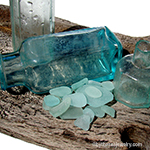Sea Glass Terms & Jewelry Glossary
Sea Glass - (or Beach Glass) in general is used to describe any found glass on beaches that has been naturally worn smooth by tide and time. Sea Glass pieces must be smoothed to be considered "real' sea glass. Glass that has any shiny or has glossiness is considered "uncooked".
Sea Glass is found on ocean beaches, beach glass is found on lakes, rivers and other waterways. While sea glass CAN BE called "Beach Glass" (found on a beach), Beach Glass should not be called sea glass if it is found on fresh water areas (unless you call it Inland Sea Glass). The quality of the two can vary BUT this is not a hard and fast rule. Many beach glass pieces found on the Great Lakes and other major waterways cannot be distinguished from sea glass.
The following alphabetical glossary describes different terms used to describe sea glass.
(This glossary may not be used in whole or part without specific consent from By The Sea Jewelry).
|
Art Sea Glass - Sea glass that originated as art glass glass or was a decorative household item that was broken and discarded into the sea. Art glass can be found on many beaches and is usually a single object cherished by a seaside resident. This type of sea glass is extremely rare .Though found on many beaches, there are 3 beaches in the world, one in California, one in Venice, and one in England that yield very different types or Art Sea Glass. |
|
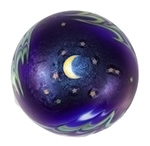 |
1. Lundberg Art Glass Scraps - The California art scrap glass is from ONE studio on the Pacific. A premier art glass manufacturing company that produced some of the finest art glass of our times. Lundberg Studios, located in the small coastal town of Davenport, California was founded by James Lundberg, in 1970. A master craftsman who created an exquisite array of vases, scent bottles, paperweights, lighting and custom commissions. Sea Glass pieces found there include millefiori rods and iridescent glass and multi color glass can be found in this location. |
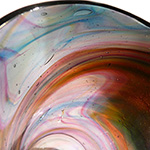 |
2. Seaham Art Sea Glass - The sea glass from region was mainly the byproduct of glass making and glass making wastes. This glass includes fisheyes or pontil sea glass pieces, flashed sea glass, multi colored sea glass and brightly colored sea glass. Many glass companies produced glass in this region. We believe that an artist by the name of James Hartley And Wood Company, originally The Wear Glass Works, established in Sunderland 1837 and then traded as Hartley Wood and Co Ltd from 1895 produced much of the multi colored art glass scraps found on these beaches. Glass Whimsies or Friggers are also found on these beaches. (see Whimsies). |
 |
3. Venetian Sea Glass - Venetian Sea Glass has it's own qualities and characteristics. Hard to acquire as you need to dive to get most of it. The Venetians are very protective of their centuries of glass making and dump the waste glass where it cannot be easily accessed. |
 |
Blown glass - The shaping of glass by blowing air through a hollow rod into the center of a molten glass gather. Blown glass does not have seems but may have a pontil scar. Glass is first "gathered" on the pontil or punty while it is molten, then shaped by the glass artist. Glass blowing techniques invented by the Phoenicians on the Syro-Palestinian coast. 23-79 A.D. ~ Ancient Historian Pliny suggests shipwrecked Phoenician sailors accidentally discovered glass making. 1st Century B.C |
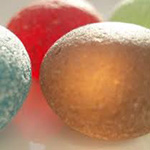 |
Boulder's - Sea glass pieces of massive size and very round. The largest boulder know to date weighs over 8 pounds. Most started as lumps of slag or cullet glass cleaned from kilns. Boulders vary greatly from most found sea glass and they tend to be VERY ROUND and VERY THICK as they were never turned into an end product. Sea Glass Boulders are generally found around glass making regions. |
 |
Bonfire Glass - (also called campfire or trash fire glass) - Sea glass that was first melted in a fire then smoothed by the sea. Features of this sea glass can include mixed colors, internal debris, bumpy texture. When sea glass or glass burns at high temperatures–usually around 2,000 degrees Fahrenheit–it melts and blends or fuses with other glass and other materials nearby such as metal and inorganic materials. |
|
|
Bottle Glass - Sea glass originating from old bottles (and jars). This is the most prevalent of sea glass types. This sea glass is found on most beaches of the world. It was not until 1500 BC that the first hollow glass container was made by covering a sand core with a layer of molten glass. Glass blowing became the most common way to make glass containers from the First Century BC. |
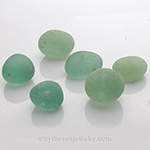 |
Bubbles - (also see Gemballs) Smaller version of boulder's (see above) Sea glass pieces that are almost perfectly round. Bubbles are mainly found in Seaham England and unlike sea glass originating from bottles or jars, started as lumps of scrap glass |
|
Cane - Color rods wrapped around each other creating unique color patterns. (see Millefiori) Also Glass Canes were made my glassmakers at the end of the day to practice skills. |
|
 |
Certified Genuine Sea Glass - Sea glass that has been rated on the following values, rarity, color and quality. Certified sea glass also defines the possible original source for the sea glass, the area it was collected and the color. Each piece of our sea glass comes with the most complete certification our 30+ years of collecting can include. The term "Certified Genuine Sea Glass is a proprietary term of By The Sea Jewelry. This certification is valuable when presenting our sea glass jewelry as a gift. |
|
Curvature - Usually indicates a piece of sea glass was a production item such as a bottle or jar. |
|
|
Embossing - Embossing was used widely in commercial products before the use of printed labels. Embossing is where the product name and other information is molded with the glass bottle. Other sources of embossed sea glass pieces are window pieces that had texture. Sea glass that has embossing s very desirable and can give a clue to age and origin. Embossing is also used in decorative glass wares. |
|
|
English Sea Glass - (also see End Of Day Sea Glass or Mulit Sea Glass) - English End of Day sea glass comes from a small beach in County Durham England around the town of Seaham. It is the byproduct of a glass making industry that spanned from the late 1800's or Victorian period, the the industrial era of the early 1900s. Though most coastal areas of England have sea glass, English Sea Glass is meant to describe sea glass exclusively from Seaham England and the Tyne and Wear region. |
|
|
Features - Features in sea glass means distinguishing parts of the sea glass and include things such as bubbles, embossing (writing in the glass), shape that indicates age and or origin (marbles, insulator marks color, shape, thickness, curvature, etc). |
|
|
Fish eyes - ( see Pontil Sea Glass Pieces) - Fish eye is the term in England used to describe the discarded punty tips from the glass making industry |
|
|
Flashed Glass - a flat rolled glass that includes 2 or more colors and was used for windows in England. Flashed sea glass pieces are generally flatter than other sea glass from this area. |
|
|
Frost - One of the features of sea glass that indicates authenticity. Frost happens when glass has been in water for long periods of time. The water leaches out the soda and lime in the glass, creating a white "frost" |
|
|
Gemballs - Very round pieces of sea glass |
|
|
Genuine Sea Glass - (also see Certified Genuine Sea Glass) Genuine sea glass is glass that has not been shaped by man made or artificial means. Genuine Sea Glass (also called - natural sea glass, authentic sea glass, real sea glass, mermaids tears, ocean glass etc). Chemical or mechanical means are never used. Only nature and time can make Genuine sea glass. |
|
|
Hydration - Part of the aging of sea glass. The process where hydrogen ions in water replace the sodium ions or soda in glass resulting in sodium hydroxide. |
|
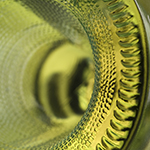 |
Kick-ups - (also called Push Up) A kick-up is a steep rise or pushed-up portion of the base which somewhat reduces the interior volume of the bottle, though it was done primarily for strength enhancing, stability, and possibly content sedimentation. Modern sea glass kick-ups are the bottoms of bottles such as Champagne and wine bottles. The thickness and degree of the kick up can determine age. |
 |
Marbles - Sea Glass marbles are found around the world. Possible sources were children's toys, ballast for ships, spray paint can marbles and Codd Bottle closures. The most common sea glass marbles are machine made cats eye marbles. The rarest are the handmade marbles called Onionskin or Swirl Core marbles. Ceramic or Clay marbles are also found on beaches around the world |
 |
Milli / Millefiori - The Italian term, "thousand flowers," used to describe mosaic glass objects. The millefiori technique involves the production of glass canes or rods, known as murine, with multicolored patterns which are viewable only from the cut ends of the cane. A murine rod is heated in a furnace and pulled until thin while still maintaining the cross section's design. It is then cut into beads or discs when cooled. |
 |
Multi Sea Glass - Sea Glass with mixed colors originating from Seaham England. |
|
Pattern Sea Glass - (also see embossed Sea Glass) - Sea glass pieces that bear a distinctive pattern. These markings may include product names and decorative patterning. |
|
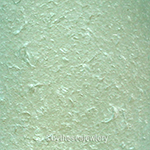 |
Pores - (also see pitting) Pores in sea glass under a microscope resemble small "C" shapes and are another indication of genuine sea glass. They are a result of rocks, sand and gravel scouring the surface of the aging hydrated glass.
Pores are just one of the features that let you know that sea glass is real or genuine and has not been man-made. |
 |
Pontil Pieces - (also call fish eyes) are found sea glass pieces in Seaham England that were once the tip glass part of a pontil or punty rod. When the product was finished being blown or
molded, the rod was slightly pulled and snapped off. The color inside of fisheyes show how the outside of the glass cooled, yet inside continued to stretch. Fisheyes are unique to Seaham England and found no where else in the world. |
|
|
Pitting - (also see Pores) Pitting in sea glass is the result of years of tumbling in water, gravel and sand. Pitting in Genuine Sea Glass will always be irregular sizes. Pitting in sea glass is ONLY achievable by many years hydration in water. Heavier pitting indicates both age and environment. Rocky beaches tend to produce sea glass with more pitting. |
|
Punty (or Pontil Rod) - The metal rod used in glass making to either "gather" molten glass from the glass kiln for blowing or molding. Pontil scars are visible on many handmade glass objects and can therefor be a feature of sea glass.
|
|
|
Rarity - Sea Glass rarity is based on several features. Similar to rare gemstones, color size and condition are the main features. Other factors may made a piece more valuable such as Shape. color, grade, frost, thickness, condition, size, bubbles, embossing, source indicators. |
|
 |
Ridged Sea Glass - Tops of old bottles and jars that used threaded tops. One of the most common bottle closures of the 20th century and has a wide array of variations. Screw tops became widely used when glass started to be machine made. It is distinguished by having some type of raised ridge or ridges on the outside surface of the finish that accepted an appropriately shaped cap which tightened and sealed the bottle when twisted. |
|
Rounds - Sea Glass pieces that were the bottoms of bottles. These sea glass pieces tend to remain whole as they were the thickest part of the bottle surviving breakage. They are often wonderful finds as they origin of the sea glass piece can sometimes be determined by the thickness or embossing on the bottle bottom. |
|
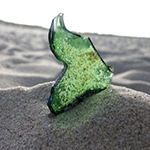 |
Shard - Sometimes used to refer to a piece of sea glass. We however prefer the term Remnant for a sea glass piece as "shard" usually refers to pottery or something sharp. The International Sea Glass Association (formerly the North America Sea Glass Association) has a "Shard of the Year" contest at all of their festivals. |
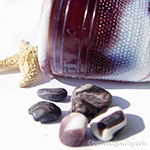 |
Slag glass is a collectors' name for opaque pressed glass with coloured streaks, usually white and/or cream streaks like this brown bugle made by George Davidson's in the North East of England in the 1890's. Slag glass is commonly found in purple, less common in blue and brown and green.
Slag Glass - The is also a reference to the leftover product of the glass making industry. |
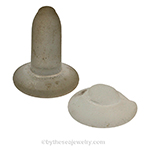 |
Stoppers - Glass bottle stoppers. Apothecary stoppers Used before commercial bottle closures were used. Sea Glass stoppers are found around the world. The most common is a seafoam green color and was used in Heinz 57 sauce. Glass corks were developed in Germany and designed to look like decanter stoppers. They achieve a tight seal by way of a plastic O-ring that allows for a snug fit between stopper and bottle.
|
 |
Sun Turned Glass - Is glass that has changed color because of exposure to strong radiation. The same effect can often be achieved over a very long period by exposure to strong sunlight. Manganese was widely used before about 1930 to de-colorize impurities from clear pressed glass. Some glass works went on using manganese after that time and some may still use it today. When irradiated or exposed to the sun for many years, antique glass with manganese turns purple. |
 |
"True" End Of Day Sea Glass - (sometimes called Spatter Glass) This is glass that was made purposefully and incorporates different colors in one finished piece. A term to describe an object made with two or more colors swirled together as commonly seen in glassware; refers to workers in factories combining small leftover batches of glass at the end of the day to avoid wasting costly materials. |
|
Unaltered Sea Glass - Sea glass that is in the same state it was found on the beach. The piece has not been shaped or frosted by artificial means. Placing beach found sea glass in a tumbler to remove sharp edges devalues the glass as it removes the frost. |
|
 |
Whimsies (or friggers) - A term used in the glass making industry. These were pieces were non production pieces the glass makers practiced their trade. Sea Glass Whimsies include portions of glass dumps (pictured here with a found dump and a antique glass dump) glass canes, paperweights or dumps, rolling pins, pipes, figurines, sock darners, gavels, doorstops etc. Most friggers were made from the molten glass that remained in the pot at the end of the day. American glassworkers referred to friggers as “end-of-day” objects. They are also known as whimsies. |
Jewelry Terms
Bail - The loop at the top of a pendant from which a pendant, watch, stone, etc., may be hung from a chain, cord or wire.
Bangle - A non-flexible or barely flexible bracelet made of solid or hollow metal or wire. May be one piece so that it may be slipped over the hand to hang loosely, or with a hinge so that it may be opened and fastened around the wrist.
We use sterling silver bangles.
Burnishing - The process of rubbing metal against metal to create a high polish.
We use both hand burnishers in our Fine Silver pieces, and Mechanical burnishing consisting of stainless steel shot in a vibratory tumbler used for small pieces.
Cable Chain - A chain made of round linked rings of uniform size. This tends to be what most people think of when they think of the word "chain"
Cabochon - A style of cutting in which the top of the stone forms a curved convex surface. May be round, oval, or square in shape with a flat back.
Used in our Limited Edition pieces.
Casting - A process for forming or duplicating jewelry objects by forcing molten metal into an investment mold from which the pattern has been burned out.
We use many cast components our jewelry such as charms and beads and rings.
Clasp - Any type of attachment that connects the two ends of a piece of jewelry. Primarily used in wrist and neck ware. Available in a wide variety of types
Our clasps include Lobster, Spring and Toggle
Clip-back Earring (Clip On Earring) A hinged ring with a pad, called a "comfort back", at one end to secure the earring to the earlobe without requiring that the ear be pierced.
These are available for most styles of our earrings.
Cuff Bracelet - A wide rigid bangle with a narrow opening on one side to allow the the wrist to pass through.
Deluxe Wire Bezel - (also see Wire Bezel) - Incorporates our Original wire bezel setting with a cast bail for a seamless, elegant and fully reversible look.
This is an ORIGINAL proprietary setting of By The Sea Jewelry and one of our most popular settings. We do not alter the sea glass in any way.
Earwire - Portion of earring that goes through a pierced ear.
French wire/Fishhook - type of finding for pierced ears that is similar in appearance to a fishhook. We used mainly French wire earrings with 3mm ball.
These are machine made and of the highest quality available.
Filigree -is a delicate kind of metalwork made with tiny beads or twisted threads, or both in combination, soldered together or to the surface of an object of the same metal and arranged in artistic motifs. It often suggests lacework.
Findings - Parts of jewelry such as clasps, links, loops, earring parts, etc.
Fine Silver - Silver having a minimum fineness of 999; considered to be pure silver. It is often used as components is our Limited Edition sea glass jewelry pieces. Fine Silver Bezel Wire (see Bezel) is purer and softer than Sterling Silver and is used in combination with Sterling.
Gemstones - A mineral or petrified material that when cut and polished can be used in jewelry.
Our uses include beads and cabochons.
Gold Filled - Gold-filled jewelry, also known as "rolled gold" is composed of a solid layer of gold bonded with heat and pressure to a base metal such as brass. Some high quality gold-filled pieces have the same appearance as 14 karat (58%) gold. This differs greatly from Gold Plated - Gold-filled items are 50 to 100,000 times thicker than regular Gold Plating and can last a lifetime with proper care.
Gold-filled jewelry allows us to offer this metal at a fraction of the cost of solid gold.
Gold plated - A piece of jewelry with a wafer thin coating of gold electroplated or mechanically plated onto a base metal. Generally 1/100th gold content.
Hammered - A texture applied to the surface of an object with a hammer to give it a flattened look.
We use hammering in our Squiggles and Waves settings.
Head Pin - A wire of varying length that has been manipulated at one end to form a flat round surface.
We used machined and closed end headpins and homemade headpins with closed ends. Headpins with swirls and open components may become caught in clothing and hair.
Hypo-Allergenic Ear Wire - Materials used in the manufacture of earring wires that provide maximum protection against allergic reactions; a.k.a. surgical steel posts.
We use two varieties to complement gold or silver earrings.
Jewelers Epoxy - Epoxy is a 2 part process used by many fine silver and goldsmiths to secure jewelry components (such and half drilled beads).
Some of our Bezel Wire pieces use jewelers epoxy as we do NOT alter or destroy our sea glass by channeling the outside and inlaying wire.
Jump Ring - A plain wire ring used for attaching adjacent jewelry parts. In general, the ends of the wire are bent together, but not soldered. May be of any size, either round or oval in shape. When used with lockets or pendants, it may be called a loop.
We use purchased high grade jump rings for surety and quality.
Leverbacks - Earring finding that secures the earring in the back. Similar to a Fishhook earring that closes
Lobster Claw - A clasp, shaped somewhat like a lobster's claw, in which one end has a heavier section concealing a spring mechanism, while the other end has one moveable section which opens and closes. Generally used as a chain clasp. Also called a snap clasp or a boat hook.
We use the heaviest top quality lobster claw clasps suitable to each piece. Most of our bracelets use Lobster Clasps that have been soldered to the bracelet.
Minimum Bezel Setting - A silver smithed setting that has no back used mainly with round pieces (see bubbles below in sea glass definitions).
Necklace Chain - Chain that is used with a pendant (necklace drop).
We use various chains with our jewelry. Pendants come with free (gold or silver plated) chains, but finer options are available. Our complete necklaces include sterling silver or gold-filled and are included in the total price.
Neck Wire - Solid necklace
Omega chain - Unlike most chains which are a series of linked rings, an Omega chain is made up of rectangular smooth rounded metal plates set side by side and crimped along the ends onto a strip of metal mesh. The end result is a fairly stiff, yet flexible, circle which needs to be worn high around the neck since it is not nearly as attractive when viewed from the edges.
Open Setting - A sea glass setting with the sides open or cut away so that the lower portion of the sea glass is visible.
Our open setting is called the Peek -A - Boo setting.
Pendant - An ornament designed to be suspended from a chain or necklace.
Our pendants are sold with a free PLATED chain, but other options are available on all pendants.
Post - A pin-like finding attached to an earring. It passes through the pierced earlobe, and may be held on by a matching clutch or ear nut. The metal thread attached to a pierced earring for passage through the earlobe.
Some or our earrings are convertible to posts.
Prong - A claw or wire used to fasten and hold a sea glass piece in a setting.
Prongs are used on our rings and some of our Limited Edition pieces.
Rollo Chain - A Rollo style chain is composed of individually linked round or oval rings resembling a standard cable chain, but with thicker rings.
Our role chain comes in 6.4 mm and 4.2 mm and is fully soldered chain used in bracelets and necklaces.
Sterling Silver - Denotes an alloy of 925/1000th parts or 92.5% pure silver. A piece of sterling silver is usually identified with a "925" stamp somewhere on the jewelry. We use many forms of Sterling Silver in our jewelry including in round wires, half round wires, sheet and findings. Also referred to as just "Sterling"
All of our wire jewelry is made with Sterling Silver
Signet Ring - A ring setting where no prongs are visible. A great durable setting.
Snake Chain - Machine chain – round, square, rectangular or oval; joints between links are connected to be flexible like a snake.
Solder - is a fusible metal alloy used to join together metal work pieces and having a melting point below that of the work piece.
We use many types of solder in our work.
Spring Clasp - Probably just about the most common of clasps, this spring ring clasps are used on beaded items like necklaces and bracelets. There is actually a little spring inside of the round part of the clasp that allows it to open and close. These come in silver, gold, gold-filled, and base metals. Spring ring clasps are available in different diameter.
Spring clasps are on our free plated chains and on some of our snake chains.
Stud Earrings - An earring with a fixed bar from a circular back piece to the ornamental sea glass head.
Stud earrings come with "nuts" to secure the back. We also have comfort backs for larger heavier earrings. These consist of a rubber disk or stopper that secures the earring to the ear.
Tarnish - A dulled luster or finish caused by a thin deposit of a dirt which discolors the surface of metal and is easily removed. Also a reaction between metals and other chemicals which discolors the surface, particularly silver which reacts with sulfur. The silver sulfide can be removed with a proprietary cleaning product and gentle abrasion.
We recommend cleaning our sterling and fine silver jewelry with non paste silver polishes as pastes may become stuck in the pores or the sea glass.
Tempering - Reducing the brittleness of hardened metal by gradual heating to stages less than annealing heat.
Textured Finishes - Any finish other than high polish; includes Florentine, bark, satin, hammered, woven, nugget, granulated, bright-cut, etc.
Used on many of the backs of our pieces to reduce the need for polishing.
Tiara - Hairpiece worn like a crown; usually set with gems in our case, sea glass.
Our tiaras are designed to be later converted to necklaces for dual purpose and a lifetime of enjoyment.
Tie Tac - Short (about ½") pin with an ornamental top. Stuck through the tie, it pins the tie to the shirt by means of a clutch back
Our tie tacs are fine set in silver and not glued to a backing.
Toggle Clasp: A means of fastening two ends of a chain together consisting of a ring on one end and a short bar on the other. The bar is slid through the ring and sits across it so it does not slide or pull.
Wire Bezel - (also see Deluxe Wire Bezel) By the sea jewelry has 2 types of wire bezel settings. Our "Original Wire Bezel" encompasses the sea glass in gold or sterling wire without use of solder. These pieces are never channeled or harmed in anyway and will last a lifetime with proper care.
NOTE - We have sold over 10,000 wire bezels pieces in 15 years and have never had one returned for resetting. The sea glass in wire bezels MAY be removed with days of soaking in solvent and can reset at a later time, keeping the glass intact and undamaged. We guarantee this setting for a lifetime!
Wire Wrapped / Wire Wrapping - An ancient jewelry technique dating back to the Egyptians. There is no use of glues or solder in wire wrapping. Wire wrapping is conducive to sea glass jewelry and many pieces are uneven and have curvature making them unable to be set in other manners.
Our settings in wire wrapping include a basic setting, side wrapped, deco, wright style, triple wrapped, squiggles and waved but are not limited only to these. Our technique or wire wrapping has been perfected over 25 years and is secure. Using the architecture of the glass, we secure a minimum of 3 points guaranteeing that a wire wrapped piece will not fall out.
Ultrasonic Cleaner - A machine that cleans jewelry by using a fluid that is vibrated at 20,000 cycles per second. When the vibration speed rises above the ultrasonic frequency level, bubbles explode and generate strong power, cleaning the surfaces and cavities of hard-to-clean objects. Ultrasonic cleaning does not scratch the surface or harm objects like many chemical or abrasive cleansers.
We use ultrasonic cleaning in our construction of jewelry and as a finishing. Ultrasonic cleaners should be used cautiously with older drilled sea glass jewelry pieces such as English Sea Glass (see sea glass definitions) due to the fact the glass was rarely tempered and may induce inclusions that will fracture with ultrasonic machines. All of our drilled English sea glass pieces have already been sonic cleaned and are therefore durable.
Vermeil - A combination of sterling silver, gold, and other precious metals, commonly used as a component in jewelry. A typical example is sterling silver coated with 14 carat (58%) gold. To be considered vermeil, the gold must be at least 10 carat (42%) and be at least 2.5 micrometers thick. In the US, sterling silver covered with a base metal (such as nickel) and plated with gold cannot be sold as vermeil without disclosing that it contains base metal.
We used vermeil in our gold Omega chains.

